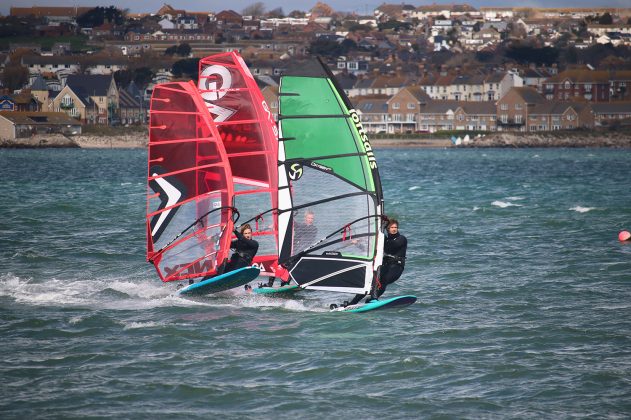7.0M NO-CAM SAIL TEST 2021
STARTER’S ORDERS
Editor: Tris Best // Second Testers: Maurin Rottenwalter, Joe North And Scott Stallman // Photos: Bryony Webb // Location: Portland Harbour
A sail of this 7.0 size often has a tough design brief to fulfil. A light wind powerhouse … or a slippery, efficient no-cam thoroughbred for blistering speed runs? Is it a race to get going the earliest, or a race against your peers down the speed strip? What’s your preference? Quite often, the marketing hyperbole of a brand states that their sail has its feet placed firmly in both camps. But is that even possible? Then add to that the additional ask of being a kick-start catalyst for a wind foiling setup possibly and you begin to realise the enormity of the task ahead for these 7.0m no-cams.
FINDINGS
The no-cam has evolved superbly over the last 25 years, ironically adopting many of the lessons learned in their respective brand’s camber-induced race programme. Mast technology has played a massive role in assisting this, providing lighter, more responsive, and more reliable spines to the sail’s structure. It’s allowed for more pronounced luff curves, increasing skin tension and promoting stability. But as with all things, go too far down one development path and you sacrifice other desirable assets. Too much luff curve makes the sail feel dead and heavy in the hands, for example, requiring a solid driving wind before it really comes to life. The iterative design process continues, experimenting with luff curves, panel layouts, materials and outlines to find the happy medium. An increasingly consistent concept endorsed amongst the brands for 2021 is the importance and relevance of the luff panel. ‘Vertical seam and panel shaping’; a ‘single continuous luff construction’ from head to tack – there are references made in many of the brands’ literature. In essence, the aim of the idea is easy to understand: to control the relationship between the head and tack – one of the primary plains of structural stresses within the sail. In doing so, the material used in the luff panel (and its seams) can be chosen to more accurately determine the structural integrity of the sail, its power delivery style … in fact pretty much every facet of the sail’s performance. There are several methods and techniques used amongst these test sails to achieve their goal.
SUMMARY
Starting with the sail with the lowest batten count, the Goya Nexus was subbed into this test as its sibling, the Mark Pro, was tested last year and remained unchanged. And its inclusion unwittingly provided a useful benchmark to compare just how good straightforward freeride sails can perform in this size. Easy to rig, sail and get on with, it demonstrated that the label ‘freeride’ doesn’t need to translate to any drop in focus or quality. The Gunsails Zoom is new for this season and carries the freeride mantle too, albeit in a more traditional and directional 6-batten format. Doing everything that is asked of it, the Zoom is well mannered and user-friendly, blending into the background and letting the rider focus on their own performance. The Matrix from GA Sails is a big, grunty powerhouse, whose balance and constant feedback make it a potent engine in light to powered conditions. Severne’s NCX, on the other hand, is at the other end of the scale, feeling small for its size and whilst getting going surprisingly early, really only displays true fire in its belly when properly powered. The Oxygen from Loftsails offers a similar outcome, but with a very different power delivery and style. Whereas the NCX has a good natural range, the Oxygen’s settings should be played with to make best use of its subtle delivery in marginal conditions. Re-tune it as the conditions come alive and it’s a match for any here … almost! The Speedster from Neil Pryde takes our top spot for accessible speed and race-bred potency. It is pure dynamite off the wind … not so good coming back upwind, but when it feels this good on the fastest point of sail, how can we not forgive it? Point-7’s AC-X is also a stunningly quick no-cam and found particular favour with those that prefer a more obvious, solid power delivery. Using a higher, more rearward centre of effort, it offers the usable leverage over a wide wind range and is a giant killer when fully wound up to speed. The two last sails are unique for very different reasons. The Compact Fire from RRD is the largest sail we’ve tested of the brand’s Compact Series. And whilst the tangible softness of the multi-piece mast fights against its capacity to deliver bottom end drive, the liberation and practicality of its packaged form are attributes to be celebrated and hopefully emulated. And finally, there’s the E_Pace from Duotone – the sail that sports the most reduced luff curve of the group, the widest tuneable wind range and quite easily the most versatile nature. Can we, as consumers, be greedy and demand a no-cam sail to fulfil multiple roles? Well, it seems we can!
7.0M NO-CAM SAIL TEST 2021
THE LINEUP

